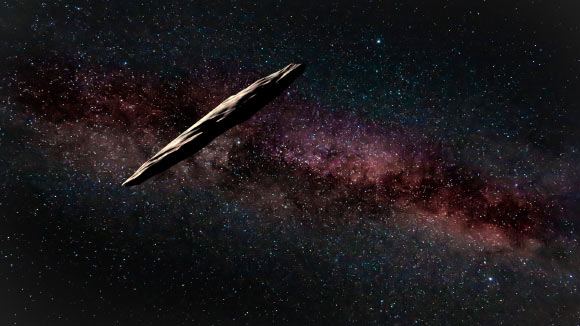In October 2017, astronomers made a surprising discovery with the Pan-STARRS1 telescope in Hawai’i — 1I/2017 U1 ‘Oumuamua, the first asteroid of extrasolar origin identified in our Solar System. Now, an international team led by Professor Alan Fitzsimmons and Dr. Michele Bannister of Queen’s University Belfast has found that the surface of ‘Oumuamua is similar to organically rich surfaces found in the outer Solar System.

This artist’s impression shows ‘Oumuamua. Image credit: Joy Pollard / Gemini Observatory / AURA / NSF.
‘Oumuamua was discovered on October 19, 2017, by University of Hawaii astronomer Robert Weryk using the Pan-STARRS telescope at Haleakala Observatory.
The object initially looked like a typical fast-moving small asteroid, but additional observations allowed its orbit to be computed fairly accurately. The calculations revealed beyond any doubt that the body did not originate from inside the Solar System, like all other asteroids or comets ever observed, but instead had come from interstellar space.
Although originally classified as a comet, further observations revealed no signs of cometary activity after it passed closest to the Sun in September 2017. The object was reclassified as an interstellar asteroid and named 1I/2017 U1.
Professor Fitzsimmons, Dr. Bannister and their colleagues have now pieced together a profile of this strange body.
“We’ve measured the way that ‘Oumuamua reflects sunlight, and found it similar to icy objects covered with a dry crust,” Professor Fitzsimmons commented.
“This is because ‘Oumuamua has been exposed to cosmic rays for millions, or even billions, of years, creating an insulating organic-rich layer on its surface.”
‘Oumuamua’s dry crust could have protected its icy interior from being vaporized — even though the object was just 23 million miles (37 million km) from the Sun in September 2017 when it zipped past.
“We’ve discovered that the surface of ‘Oumuamua is similar to small solar system bodies that are covered in carbon-rich ices, whose structure is modified by exposure to cosmic rays,” Professor Fitzsimmons said.
“We’ve also found that a 20-inch (0.5 m) thick coating of organic-rich material could have protected a water-ice-rich comet-like interior from vaporizing when the object was heated by the Sun, even though it was heated to over 300 degrees centigrade.”

Gemini South telescope color composite image of ‘Oumuamua. Image credit: Gemini Observatory / AURA / NSF.
The researchers observed ‘Oumuamua while it was still within reach of the largest telescopes in the world.
They found the object was the same color as some of the icy minor planets in the outskirts of our Solar System.
“This implies that different planetary systems in our Milky Way Galaxy contain minor planets like our own,” the scientists said.
“We’ve discovered that this is a planetesimal with a well-baked crust that looks a lot like the tiniest worlds in the outer regions of our Solar System, has a grayish/red surface and is highly elongated with an axial ratio of at least 5.3:1, implying that it has significant internal cohesion,” Dr. Bannister said.
“It’s fascinating that the first interstellar object discovered looks so much like a tiny world from our own home system. This suggests that the way our planets and asteroids formed has a lot of kinship to the systems around other stars.”
The team’s results appear in the journal Nature Astronomy and the Astrophysical Journal Letters.
_____
Alan Fitzsimmons et al. Spectroscopy and thermal modelling of the first interstellar object 1I/2017 U1 ‘Oumuamua. Nature Astronomy, published online December 18, 2017; doi: 10.1038/s41550-017-0361-4
Michele T. Bannister et al. 2017. Col-OSSOS: Colors of the Interstellar Planetesimal 1I/‘Oumuamua. ApJL, in press; arXiv: 1711.06214







